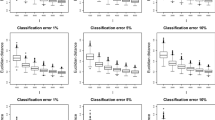Abstract
Homogeneity analysis, or multiple correspondence analysis, is usually applied tok separate variables. In this paper we apply it to sets of variables by using sums within sets. The resulting technique is called OVERALS. It uses the notion of optimal scaling, with transformations that can be multiple or single. The single transformations consist of three types: nominal, ordinal, and numerical. The corresponding OVERALS computer program minimizes a least squares loss function by using an alternating least squares algorithm. Many existing linear and nonlinear multivariate analysis techniques are shown to be special cases of OVERALS. An application to data from an epidemiological survey is presented.
Similar content being viewed by others
References
Benzécri, J. P. et al. (1973).L'Analyse des données [Data analysis] (2 vols.). Paris: Dunod.
Benzécri, J. P. et al. (1980).Pratique de l'Analyse des données [Practice of data analysis] (3 vols). Paris: Dunod.
Carroll, J. D. (1968). Generalization of canonical correlation analysis to three or more sets of variables.Proceedings of the 76th Annual Convention of the American Psychological Association, 5, 227–228.
Cliff, N. (1966). Orthogonal rotation to congruence.Psychometrika, 31, 33–42.
de Leeuw, J. (1983, July).Nonlinear joint bivariate analysis. Paper presented at the meeting of the Psychometric Society, Jouy-en-Josas, France.
de Leeuw, J. (1984a). The Gifi-system of nonlinear multivariate analysis. In E. Diday, M. Jambu, L. Lebart, J. Pagès, & R. Thomassone (Eds.),Data Analysis and Informatics III (pp. 415–424). Amsterdam: North Holland.
de Leeuw, J. (1984b).Canonical analysis of categorical data. (Doctoral dissertation, University of Leiden, 1973). Leiden: DSWO-Press.
de Leeuw, J. & van der Burg, E. (1986). The Permutational limit distribution of generalized canonical correlations. In E. Diday, Y. Escoufier, L. Lebart, J. P. Pagès, Y. Schektman, & R. Thomassone (Eds.),Data analysis and informatics IV (pp. 509–521). Amsterdam: North Holland.
de Leeuw, J., van Rijckevorsel, J., & van der Wouden, H. (1981). Nonlinear principal component analysis using B-splines.Methods of operations research, 23, 211–234.
Gifi, A. (1981).Nonlinear multivariate analysis. Department of data theory, University of Leiden. (In Press, Leiden: DSWO-Press).
Gifi, A. (1985).PRINCALS. (User's Guide UG-85-03). Department of Data Theory, University of Leiden.
Greenacre, M. J. (1984).Theory and applications of correspondence analysis. New York: Academic Press.
Guttman, L. (1941). The quantification of a class of attributes: A theory and method of scale construction. In P. Horst (Ed.),The prediction of personal adjustment. New York: Social Science Research Council.
Horst, P. (1961). Relations amongm sets of measures.Psychometrika, 26, 129–149.
Kettenring, J. R. (1971). Canonical analysis of several sets of variables.Biometrika, 56, 433–451.
Kruskal, J. B. (1964). Multidimensional scaling by optimizing goodness-of-fit to a nonmetric hypothesis.Psychometrika, 29, 1–28.
Kuhfeld, W. F. (1985).Principal components of ordered categorical data. Unpublished doctoral dissertation, University of North Carolina.
Kuhfeld, W. F., Sarle, W. S., & Young, F. W. (1985). Methods in generating model estimates in the PRINQUAL macro.SUGI-Proceedings (pp. 962–971), Cary, NC: SAS-Institute.
Lebart, L., Morineau, A., & Warwick, K. M. (1984).Multivariate descriptive analysis. New York: Wiley.
Meulman, J. (1982).Homogeneity analysis of incomplete data. Leiden: DSWO-Press.
Nishisato S. (1980).Analysis of categorical data: Dual scaling and its applications. Toronoto: University of Toronto Press.
Rutishauser, H. (1969). Computational aspects of F. L. Bauer's simultaneous iteration method.Numerische Mathematik, 13, 4–13.
Segijn, R. (1984). Lokale minima in PRINCALS [Local minima in PRINCALS]. Unpublished master's Thesis, Department of Data Theory, University of Leiden.
Takane, Y., Young, F. W., & de Leeuw, J. (1980). An individual differences additive model: An alternating least squares method with optimal scaling features.Psychometrika, 45, 183–209.
Tenenhaus, M. & Young, F. W. (1985). An analysis and synthesis of multiple correspondence analysis, optimal scaling, dual scaling, homogeneity analysis, and other methods for quantifying categorical multivariate data.Psychometrika, 50, 91–120.
Thorndike, R. M. (1977). Canonical analysis and predictor selection.Multivariate Behavioral Research, 12, 75–87.
van de Geer, J. P. (1985).HOMALS. (User's guide UG-85-02). Department of data theory, University of Leiden.
van de Geer, J. P. (1986).Introduction to multivariate data analysis (2 vols.). Leiden: DSWO-Press.
van der Burg, E. (1983).CANALS (User's guide UG-85-05). Department of Data Theory, University of Leiden.
van der Burg, E., & de Leeuw, J. (1983). Non-linear canonical correlation.British Journal of Mathematical and Statistical Psychology, 36, 54–80.
van der Burg, E., & de Leeuw, J. (1985). Use of the multinomial jackknife in generalized canonical correlation analysis. Paper presented at the Multidimensional Data Analysis Workshop, Cambridge, G.B.
van der Burg, E., de Leeuw, J., & Verdegaal, R. (1984).Nonlinear canonical correlation with m sets of variables (Research Report RR-84-12) Leiden: University of Leiden, Department of Data Theory.
van der Lende, R., Kok, T. J., Peset Reig, R., Quanjer, Ph. H., Schouten, J. P., & Orie, N. G. M. (1981). Decreases in VC and FEV with time: Indicators for effects of smoking and air pollution.Bulletin Européen de Psychopathologie Respiratoire, 17, 775–792.
van Pelt, W. J., Quanjer, Ph. W., Wise, M. E., van der Burg, E., & van der Lende, R. (1985). Analysis of maximum expiratory flow-volume curves using canonical correlation analysis.Methods of Information in Medicine, 24, 91–100.
Verdegaal, R. (1985).Meer-sets analyse voor kwalitatieve gegevens [Multi-set analysis of qualitative data] (Research Report RR-85-14). Department of Data Theory, University of Leiden.
Verdegaal, R. (1986).OVERALS (User's guide UG-86-01). Department of Data Theory, University of Leiden.
Young, F. W. (1981). Quantitative analysis of qualitative data.Psychometrika, 46, 347–388.
Young, F. W., de Leeuw, J., & Takane, Y. (1976). Regression with qualitative and quantitative variables: An alternating least squares method with optimal scaling features.Psychometrika, 41, 505–529.
Young, F. W., Takane, Y., & de Leeuw, J. (1978). The principal components of mixed measurement multivariate data: An alternating least squares method with optimal scaling features.Psychometrika, 43, 279–281.
Author information
Authors and Affiliations
Additional information
This research was partly supported by SWOV (Institute for Road Safety Research) in Leidschendam, The Netherlands.
Rights and permissions
About this article
Cite this article
van der Burg, E., de Leeuw, J. & Verdegaal, R. Homogeneity analysis withk sets of variables: An alternating least squares method with optimal scaling features. Psychometrika 53, 177–197 (1988). https://doi.org/10.1007/BF02294131
Received:
Revised:
Issue Date:
DOI: https://doi.org/10.1007/BF02294131




